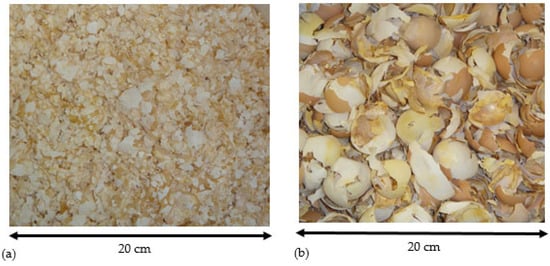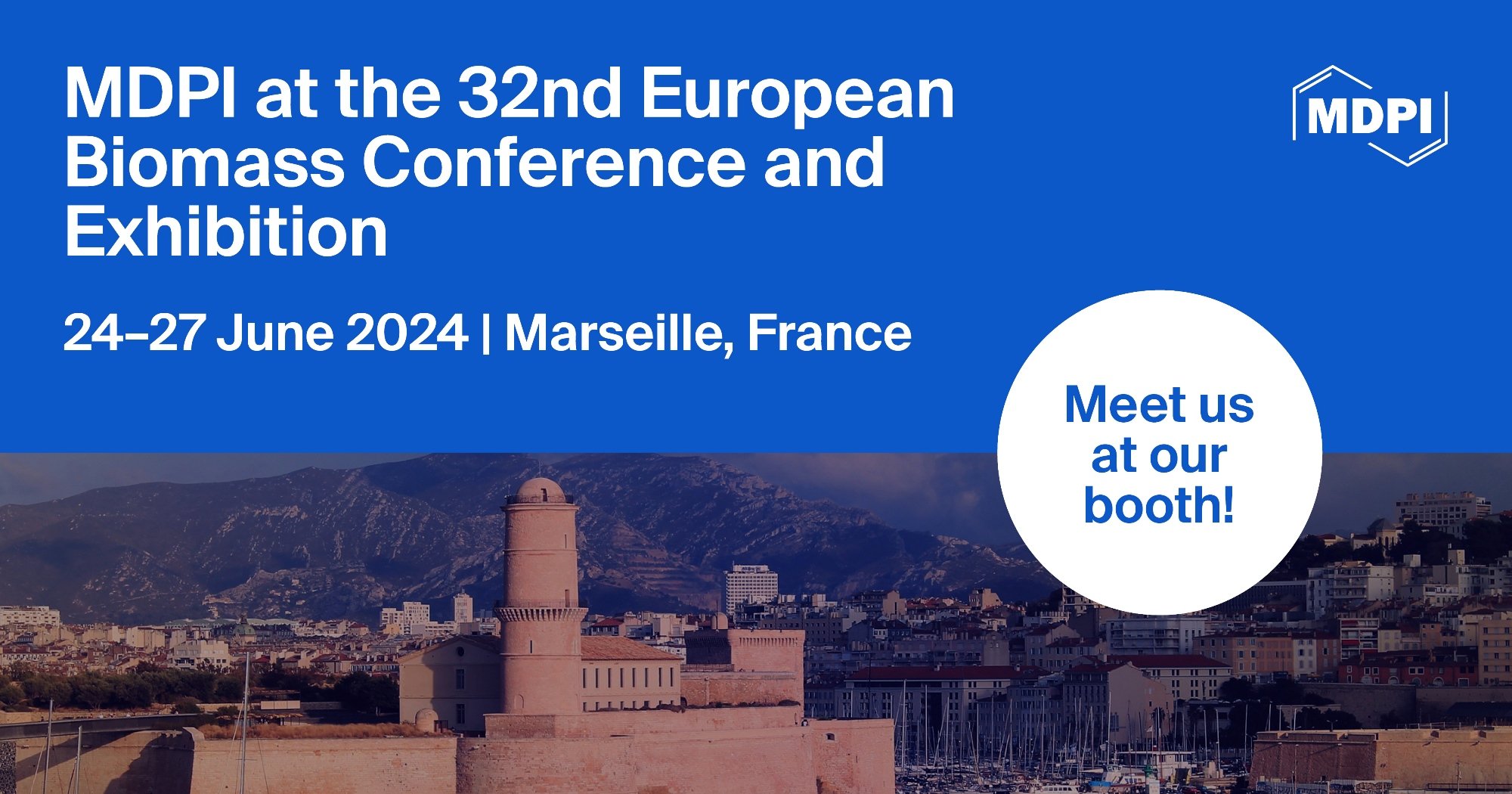Journal Description
Waste
Waste
is an international, peer-reviewed, open access journal on waste management, science and technology, published quarterly online by MDPI.
- Open Access— free for readers, with article processing charges (APC) paid by authors or their institutions.
- Rapid Publication: manuscripts are peer-reviewed and a first decision is provided to authors approximately 17.8 days after submission; acceptance to publication is undertaken in 5.7 days (median values for papers published in this journal in the second half of 2023).
- Recognition of Reviewers: APC discount vouchers, optional signed peer review, and reviewer names published annually in the journal.
subject
Imprint Information
Open Access
ISSN: 2813-0391
Latest Articles
Polylactic Acid Composites Reinforced with Eggshell/CaCO3 Filler Particles: A Review
Waste 2024, 2(2), 169-185; https://doi.org/10.3390/waste2020010 - 19 Apr 2024
Abstract
►
Show Figures
Statistics reveal that egg production has increased in recent decades. This growth suggests there is a global rise in available eggshell biomass due to the current underutilization of this bio-waste material. A number of different applications for waste eggshells (WEGs) are known, that
[...] Read more.
Statistics reveal that egg production has increased in recent decades. This growth suggests there is a global rise in available eggshell biomass due to the current underutilization of this bio-waste material. A number of different applications for waste eggshells (WEGs) are known, that include their use as an additive in human/animal food, soil amendment, cosmetics, catalyst, sorbent, and filler in polymer composites. In this article, worldwide egg production and leading countries are examined, in addition to a discussion of the various applications of eggshell biomass. Eggshells are a rich supplement of calcium carbonate; therefore, they can be added as a particulate filler to polymer composites. In turn, the addition of a lower-cost filler, such as eggshell or calcium carbonate, can reduce overall material fabrication costs. Polylactic acid (PLA) is currently a high-demand biopolymer, where the fabrication of PLA composites has gained increasing attention due to its eco-friendly properties. In this review, PLA composites that contain calcium carbonate or eggshells are emphasized, and the mechanical properties of the composites (e.g., tensile strength, flexural strength, tensile elastic modulus, flexural modulus, and elongation (%) at break) are investigated. The results from this review reveal that the addition of eggshell/calcium carbonate to PLA reduces the tensile and flexural strength of PLA composites, whereas an increase in the tensile and flexural modulus, and elongation (%) at break of composites are described herein.
Full article
Open AccessArticle
Thermo-Mechano-Chemical Processing of Printed Circuit Boards for Organic Fraction Removal
by
Sergey M. Frolov, Viktor A. Smetanyuk, Anton S. Silantiev, Ilias A. Sadykov, Fedor S. Frolov, Jaroslav K. Hasiak, Alexey A. Shiryaev and Vladimir E. Sitnikov
Waste 2024, 2(2), 153-168; https://doi.org/10.3390/waste2020009 - 15 Apr 2024
Abstract
►▼
Show Figures
Printed circuit boards (PCBs) are the main components of e-waste. In order to reduce the negative impact of waste PCBs on human health and the environment, they must be properly disposed of. A new method is demonstrated for recycling waste PCBs. It is
[...] Read more.
Printed circuit boards (PCBs) are the main components of e-waste. In order to reduce the negative impact of waste PCBs on human health and the environment, they must be properly disposed of. A new method is demonstrated for recycling waste PCBs. It is referred to as the high-temperature thermo-mechano-chemical gasification (TMCG) of PCBs by the detonation-born gasification agent (GA), which is a blend of H2O and CO2 heated to a temperature above 2000 °C. The GA is produced in a pulsed detonation gun (PDG) operating on a near-stoichiometric methane–oxygen mixture. The PDG operates in a pulsed mode producing pulsed supersonic jets of GA and pulsed shock waves possessing a huge destructive power. When the PDG is attached to a compact flow reactor filled with waste PCBs, the PCBs are subject to the intense thermo-mechano-chemical action of both strong shock waves and high-temperature supersonic jets of GA in powerful vortical structures established in the flow reactor. The shock waves grind waste PCBs into fine particles, which undergo repeated involvement and gasification in the high-temperature vortical structures of the GA. Demonstration experiments show full (above 98%) gasification of the 1 kg batch of organic matter in a setup operation time of less than 350 s. The gaseous products of PCB gasification are mainly composed of CO2, CO, H2, N2, and CH4, with the share of flammable gas components reaching about 45 vol%. The solid residues appear in the form of fine powder with visible metal inclusions of different sizes. All particles in the powder freed from the visible metal inclusions possess a size less than 300–400 μm, including a large fraction of sizes less than 100 μm. The powder contains Sn, Pb, Cu, Ni, Fe, In, Cd, Zn, Ca, Si, Al, Ti, Ni, and Cl. Among these substances, Sn (10–20 wt%), Pb (5–10 wt%), and Cu (up to 1.5 wt%) are detected in the maximum amounts. In the powder submitted for analysis, precious elements Ag, Au, and Pt are not detected. Some solid mass (about 20 wt% of the processed PCBs) is removed from the flow reactor with the escaping gas and is partly (about 10 wt%) trapped by the cyclones in the exhaust cleaning system. Metal inclusions of all visible sizes accumulate only in the flow reactor and are not detected in powder samples extracted from the cyclones. The gasification degree of the solid residues extracted from the cyclones ranges from 76 to 91 wt%, i.e., they are gasified only partly. This problem will be eliminated in future work.
Full article
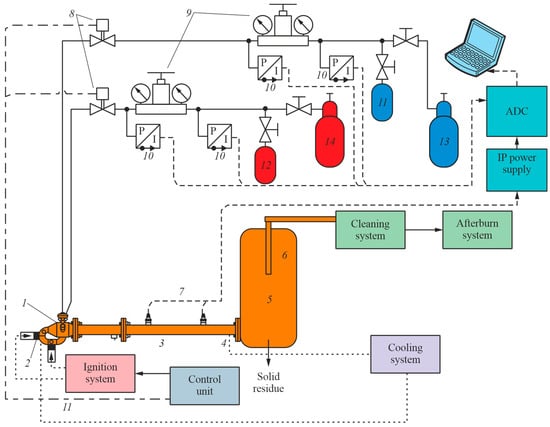
Figure 1
Open AccessReview
Influence of Recycling Processes on Properties of Fine Recycled Concrete Aggregates (FRCA): An Overview
by
Eduardo Kloeckner Sbardelotto, Karyne Ferreira dos Santos, Isabel Milagre Martins, Berenice Martins Toralles, Manuel Gomes Vieira and Catarina Brazão Farinha
Waste 2024, 2(2), 136-152; https://doi.org/10.3390/waste2020008 - 09 Apr 2024
Abstract
►▼
Show Figures
Concrete waste recycling processes involve multiple stages, equipment, and procedures which produce Fine Recycled Concrete Aggregates (FRCA) for use in construction. This research aims at performing a comprehensive overview of the recycling technologies, recycling processes, and normative requirements to produce high-quality FRCA and
[...] Read more.
Concrete waste recycling processes involve multiple stages, equipment, and procedures which produce Fine Recycled Concrete Aggregates (FRCA) for use in construction. This research aims at performing a comprehensive overview of the recycling technologies, recycling processes, and normative requirements to produce high-quality FRCA and to investigate the influence of these processes on their physical properties. The properties investigated were the particle size distribution (PSD), water absorption, oven-dry density, and adhered paste. The correlations between these properties were also investigated. The results indicate that the recycling processes with the highest potential for producing high-quality aggregates demand jaw crusher and impact crusher combinations. These processes are better suited for achieving FRCA with the desired particle size distribution and oven-dry density. However, water absorption and adhered paste, which are critical factors for obtaining high-quality FRCA, seem to be more dependent on the original material than on the recycling process.
Full article
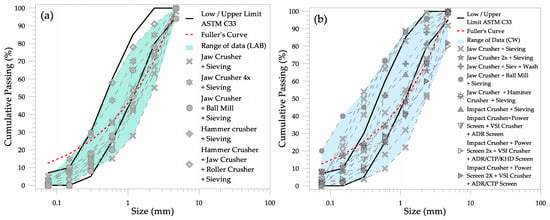
Figure 1
Open AccessArticle
Sustainable Filters with Antimicrobial Action from Sugarcane Bagasse: A Novel Waste Utilization Approach
by
Rosa Hernández-López, Aurelio López-Malo, Ricardo Navarro-Amador and Nelly Ramírez-Corona
Waste 2024, 2(1), 122-135; https://doi.org/10.3390/waste2010007 - 08 Mar 2024
Abstract
►▼
Show Figures
Sugarcane bagasse (SCB) is a waste product from Mexico’s sugar industry that is generally burned or discarded. It contains around 48% cellulose, representing a significant source of this component from industrial waste. Eugenol is found in clove oil; it has been used for
[...] Read more.
Sugarcane bagasse (SCB) is a waste product from Mexico’s sugar industry that is generally burned or discarded. It contains around 48% cellulose, representing a significant source of this component from industrial waste. Eugenol is found in clove oil; it has been used for its medicinal and antimicrobial benefits in the food and pharmaceutical industries. This study aims to develop a filtering material using sugarcane bagasse (SCB) and encapsulated eugenol as an antimicrobial agent. The study involves extracting cellulose from SCB using alkaline hydrolysis with ultrasound, followed by forming composite materials encapsulated in alginate with eugenol concentrations from 0 to 1% v/v. These materials were characterized and tested for antimicrobial efficacy. The findings indicate that the cellulose–eugenol–alginate composite displays high eugenol encapsulation efficiency and effective short-term release. In well-diffusion assays, the material showed inhibition halos up to 20.47 mm against S. aureus, suggesting its potential as an eco-friendly alternative to traditional antimicrobial agents in filter materials.
Full article
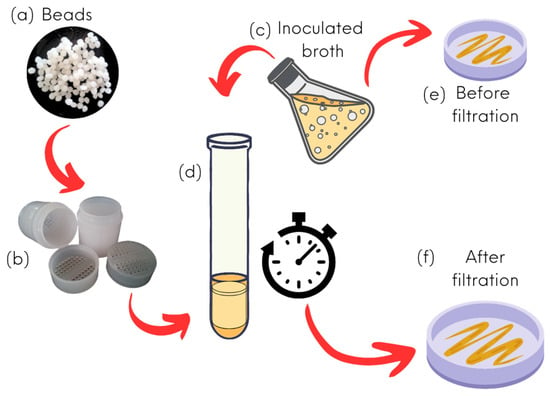
Figure 1
Open AccessArticle
Identifying Priorities for the Development of Waste Management Systems in ASEAN Cities
by
Souphaphone Soudachanh, Alessio Campitelli and Stefan Salhofer
Waste 2024, 2(1), 102-121; https://doi.org/10.3390/waste2010006 - 21 Feb 2024
Abstract
One of the largest issues facing countries, particularly emerging nations with high population, production, and consumption growth, is an inadequate waste management system (WMS). This paper analyzes the development of the waste management systems of nine capital cities in the Association of Southeast
[...] Read more.
One of the largest issues facing countries, particularly emerging nations with high population, production, and consumption growth, is an inadequate waste management system (WMS). This paper analyzes the development of the waste management systems of nine capital cities in the Association of Southeast Asian Nations (ASEAN) region by using a recently developed approach, the Waste Management System–Development Stage Concept. This concept comprises five development stages and various components, including Collection and Transport, Waste Disposal, Energy Recovery, Waste Recycling, and Waste Prevention and Reuse. The findings indicate that in terms of waste collection, waste disposal, and energy recovery, Singapore is at a higher development stage (Stage 5) and is more advanced than other ASEAN cities. For most of the components, Bangkok, Jakarta, Kuala Lumpur, and Manila fall into stages 2 to 4, whereas the early development stages 1 to 3 are present in Bandar Seri Begawan, Hanoi, Phnom Penh, and Vientiane. The results will be used to determine the next steps in developing the WMSs, including the introduction of separate collection for recycling or the installation of a waste-to-energy plant. The environmental impact of each measure will be later assessed using the LCA approach, and the most effective measures shall be identified in future studies.
Full article
(This article belongs to the Special Issue Solid Waste Management and Environmental Protection)
►▼
Show Figures
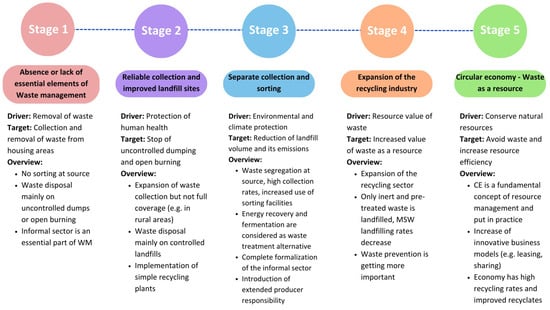
Figure 1
Open AccessArticle
Effects of Clay Minerals on Enzyme Activity as a Potential Biosensor of Soil Pollution in Alice Township
by
Nontobeko Gloria Maphuhla and Opeoluwa Oyehan Oyedeji
Waste 2024, 2(1), 85-101; https://doi.org/10.3390/waste2010005 - 09 Feb 2024
Abstract
Inadequate waste management and illegal trash dumping continue to be the leading causes of severe environmental pollution. Human exposure to harmful heavy metals has emerged as a serious health concern on the continent. Some people in Alice, a small town, grow their food
[...] Read more.
Inadequate waste management and illegal trash dumping continue to be the leading causes of severe environmental pollution. Human exposure to harmful heavy metals has emerged as a serious health concern on the continent. Some people in Alice, a small town, grow their food in home gardens. They use animal manure and compost derived from soil obtained from landfills to enhance the fertility of the garden soil. Heavy metal heaps in garbage disposals are constantly present, releasing dangerous amounts of metal into the environment. The harmful effects of heavy metals on plants lead to unsanitary conditions and environmental problems. Animals and people who consume these vegetables may also be at risk for health problems. Assessing the soil’s enzyme activity can potentially lessen the negative effects of the accumulated pollutants and improve the soil’s overall health and quality. Soil enzymes are biologically active components that have a catalytic impact and are released from root exudates, crop residues, and animal remains. The activity of enzymes serves as an excellent bioindicator of soil cleanliness and quality because they are sensitive to heavy metals. X-ray diffraction (XRD) was used to quantify the mineral elements in soil using 40 kV parallel beam optics, 30 mA, and CuKα radiation. Meanwhile, the activity of the enzyme was essayed in different coupled substrates. Thirteen (13) clay minerals were found, including Talc 2M, Kaolinite 2M, and Chlorite Lawsonite Muscovite 2M1. The detected trace elements have high concentration levels that exceed the World Health Organization’s (WHO) allowed levels. The identified elements affected the enzyme activity at different levels. The Mn, Al, Si, V, Ti, and Ca negatively affect soil enzyme activity, specifically invertase (INV). However, the amount of Mg, K, Fe, and Zn showed a slightly positive effect on the same enzyme (INV). According to this view, these elements come from several sources, each with a particular impact on soil contamination and enzyme activity. High levels of heavy metals in this study may be due to improper waste disposal, limited recycling opportunities, lack of public awareness, and inadequate enforcement of waste management regulations. It is essential to employ Fourth Industrial Revolution (4IR) technologies, correct disposal techniques, suitable agricultural methods, preventive regulations, and efficient waste management to mitigate the negative effects of heavy metals on the environment.
Full article
(This article belongs to the Special Issue Solid Waste Management and Environmental Protection)
►▼
Show Figures
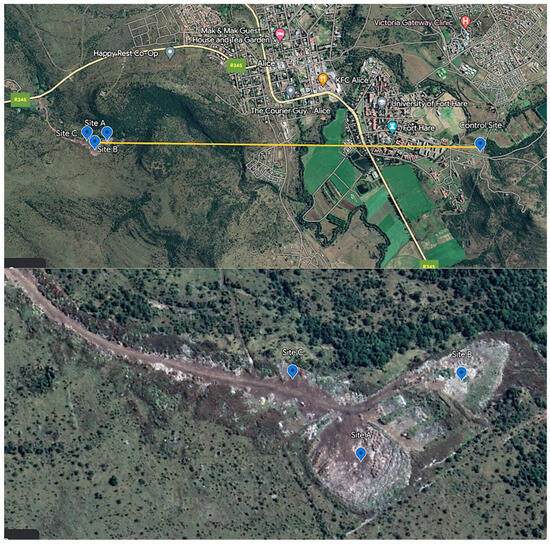
Figure 1
Open AccessArticle
Acceleration of Composting by Addition of Clinker to Tea Leaf Compost
by
Nobuki Morita, Yo Toma and Hideto Ueno
Waste 2024, 2(1), 72-84; https://doi.org/10.3390/waste2010004 - 01 Feb 2024
Abstract
The disposal of tea leaves discarded in the tea beverage market and clinker from coal-fired power plants has an impact on the environment; however, there are no reported cases of their combination for composting. Therefore, this study evaluated the effect of adding clinker
[...] Read more.
The disposal of tea leaves discarded in the tea beverage market and clinker from coal-fired power plants has an impact on the environment; however, there are no reported cases of their combination for composting. Therefore, this study evaluated the effect of adding clinker from a coal-fired power plant to compost based on tea leaves, an organic waste product, on the composting rate and quality. The tea leaves-only compost was designated as Clinker 0%, and composts with 20% (w/w), 40% (w/w), and 60% (w/w) tea leaves supplemented with clinker were designated as Clinker 20, 40, and 60%, respectively. Each mixed material was placed in a 35 L polypropylene container with a lid and allowed to compost for 95 days. The composting rate was evaluated by the chemical oxygen demand (COD) in hot water extract and plant tests using juvenile komatsuna (Brassica rapa var. perviridis). The addition of clinker reduced the COD at the beginning of composting by 52.0, 74.3, and 86.7% in Clinker 20, 40, and 60%, respectively, compared to Clinker 0%. Furthermore, root elongation one month after composting was inhibited by Clinker 0% (60.1% relative to distilled water), but not by the addition of clinker (91.7–102.7% relative to distilled water). This suggests that the addition of clinker to tea leaf compost may accelerate composting.
Full article
(This article belongs to the Special Issue Conversion of Fruit and Vegetable Waste into Sustainable and Value-Added Materials)
►▼
Show Figures
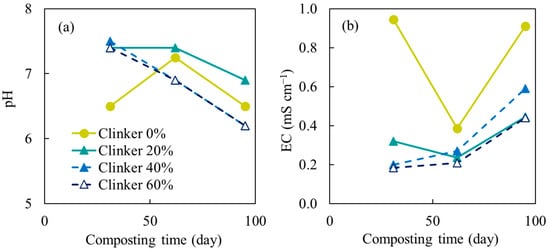
Figure 1
Open AccessArticle
Anaerobic Treatment of Food Waste with Biogas Recirculation under Psychrophilic Temperature
by
Tafannum Torsha and Catherine N. Mulligan
Waste 2024, 2(1), 58-71; https://doi.org/10.3390/waste2010003 - 23 Jan 2024
Abstract
Food waste has emerged as a pressing concern, and thus advanced techniques to valorize food waste into nutrition rich materials as well as renewable energy are highly important. The exceptional biodegradability of food waste renders it a highly suitable substrate for anaerobic treatment.
[...] Read more.
Food waste has emerged as a pressing concern, and thus advanced techniques to valorize food waste into nutrition rich materials as well as renewable energy are highly important. The exceptional biodegradability of food waste renders it a highly suitable substrate for anaerobic treatment. This leads to energy production and a reduction in the carbon footprint. Nevertheless, in frigid territories like Canada, the conventional mesophilic anaerobic digestion at 30–40 °C can require substantial amounts of energy. Consequently, this study introduces a new approach to treat food waste at psychrophilic temperatures (1–20 °C). Lower temperatures can negatively impact cellular processes during anaerobic treatment, rendering substrates less accessible to microscopic organisms. To address this challenge associated with lower temperatures, the study introduces an innovative biogas recirculation strategy. The primary objectives of this study are to assess the viability of anaerobic treatment for food waste at psychrophilic temperatures and to investigate the effectiveness of reintroduction of the produced biogas to the anaerobic system in enhancing biomethane generation and stability of the system. Batch experiments were conducted on food waste in various assessments, both with and without biogas recirculation. The outcomes revealed a methane concentration ranging from 68% to 93% when biogas recirculation was employed, whereas without this technique, methane concentration varied between 10% and 45%. Moreover, with biogas recirculation, the reduction in volatile solids reached a maximum of 92%, and there was an 82% decrease in chemical oxygen demand. In conclusion, the utilization of the recirculation of biogas at the psychrophilic temperature range enhanced biomethane production and reduction of volatile solids and chemical oxygen demand. This study underscores the potential of employing anaerobic treatment with reintroduction of produced biogas into the system in cold regions as an economically viable and sustainable choice for treating food waste with nominal energy consumption.
Full article
(This article belongs to the Special Issue Conversion and Gasification of Gaseous, Liquid and Solid Organic Wastes)
►▼
Show Figures

Figure 1
Open AccessReview
Enhancing Methane Yield in Anaerobic Co-Digestion of Primary Sewage Sludge: A Comprehensive Review on Potential Additives and Strategies
by
Foteini Sakaveli, Maria Petala, Vasilios Tsiridis and Efthymios Darakas
Waste 2024, 2(1), 29-57; https://doi.org/10.3390/waste2010002 - 16 Jan 2024
Abstract
Traditionally, anaerobic digestion has been applied to mixed sludge, combining primary sludge (PS) with secondary sludge. However, recent research has unveiled the advantages of dedicated PS digestion due to its higher energy content. Anaerobic digestion (AD) of primary sewage sludge can offer a
[...] Read more.
Traditionally, anaerobic digestion has been applied to mixed sludge, combining primary sludge (PS) with secondary sludge. However, recent research has unveiled the advantages of dedicated PS digestion due to its higher energy content. Anaerobic digestion (AD) of primary sewage sludge can offer a sustainable solution for managing sewage sludge while generating renewable energy. The present study provides a comprehensive examination of the current state of knowledge regarding the anaerobic digestion of PS. Co-digestion of PS with organic substrates, including food waste and agro-industrial residues, emerges as a promising approach to boost biogas production. Additionally, the utilization of additives such as glucose and clay minerals has shown potential in improving methane yield. Critical factors affecting AD, such as pretreatment methods, carbon-to-nitrogen (C/N) ratio, temperature, pH, volatile fatty acids (VFAs) levels, organic loading rates (OLR), inoculum-to-substrate ratio (ISR), and the role of additives, have been meticulously studied. Finally, this review consolidates existing knowledge to advance our understanding of primary sewage sludge anaerobic digestion, fostering more efficient and sustainable practices in sludge management and renewable energy generation.
Full article
(This article belongs to the Topic Valorizing Waste through Thermal and Biological Processes for Sustainable Energy Production)
►▼
Show Figures
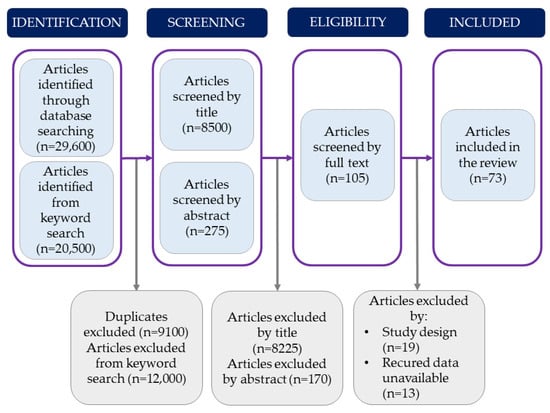
Figure 1
Open AccessReview
Unveiling the Potential of Apricot Residues: From Nutraceuticals to Bioenergy
by
Ioannis Makrygiannis, Vassilis Athanasiadis, Theodoros Chatzimitakos, Martha Mantiniotou, Eleni Bozinou and Stavros I. Lalas
Waste 2024, 2(1), 1-28; https://doi.org/10.3390/waste2010001 - 15 Jan 2024
Abstract
►▼
Show Figures
Stone fruits, such as the apricot (Prunus armeniaca L.), are frequently consumed. As such, a substantial volume of apricot waste is generated at each stage of the food supply chain, including harvesting, processing, packaging, warehousing, transportation, retailing, and eventual consumption. This generates
[...] Read more.
Stone fruits, such as the apricot (Prunus armeniaca L.), are frequently consumed. As such, a substantial volume of apricot waste is generated at each stage of the food supply chain, including harvesting, processing, packaging, warehousing, transportation, retailing, and eventual consumption. This generates tons of waste annually on a global scale. The significant amounts of phenolics present in these wastes are primarily responsible for their antioxidant capacity and the subsequent health advantages they provide. As such, apricot pulp by-products could be a valuable reservoir of bioactive compounds, such as tocopherols, polyphenolic compounds, proteins, dietary fibers, etc. Moreover, apricot kernels are also recognized for their abundance of bioactive compounds, including polyphenols and tocopherols, which find utility in diverse sectors including cosmetology and the food industry. Both conventional and green methods are employed, and generally, green methods lead to higher extraction efficiency. The antimicrobial properties of apricot kernel essential oil have been widely recognized, leading to its extensive historical usage in the treatment of diverse ailments. In addition, apricot kernel oil possesses the capacity to serve as a viable resource for renewable fuels and chemicals. This review examines the potential of apricot waste as a source of bioactive compounds, as well as its utilization in diverse applications, with an emphasis on its contribution to health improvement.
Full article

Figure 1
Open AccessArticle
Recovery of Magnetic Particles from Wastewater Formed through the Treatment of New Polycrystalline Diamond Blanks
by
Saliha Keita, Srecko Stopic, Ferdinand Kiessling, Tatjana Volkov Husovic, Elif Emil Kaya, Slavko Smiljanic and Bernd Friedrich
Waste 2023, 1(4), 993-1006; https://doi.org/10.3390/waste1040057 - 08 Dec 2023
Abstract
►▼
Show Figures
Cobalt’s pivotal role in global development, especially in lithium-ion batteries, entails driving increased demand and strengthening global trading networks. The production of different waste solutions in metallurgical operations requires the development of an environmentally friendly research strategy. The ultrasonic spray pyrolysis and hydrogen
[...] Read more.
Cobalt’s pivotal role in global development, especially in lithium-ion batteries, entails driving increased demand and strengthening global trading networks. The production of different waste solutions in metallurgical operations requires the development of an environmentally friendly research strategy. The ultrasonic spray pyrolysis and hydrogen reduction method were chosen to produce nanosized magnetic powders from waste solution based on iron and cobalt obtained during the purification process of used polycrystalline diamond blanks. With specific objectives focused on investigating the impact of reaction temperature and residence time on the morphology, chemical composition, and crystal structure of synthesized nanosized cobalt powders, our research involved 15 experimental runs using two reactors with varying residence times (7.19 s and 23 s) and distinct precursors (A, B, and C). Aerosol droplets were reduced at 600 to 900 °C with a flow rate of 3 L/min of argon and hydrogen (1:2). Characterization via scanning electron microscopy (SEM), energy dispersive spectroscopy (EDS), and X-ray diffraction revealed that higher temperatures influenced the spherical particle morphology. Altering cobalt concentration in the solution impacted the particle size, with higher concentrations yielding larger particles. A short residence time (7.9 s) at 900 °C proved optimal for cobalt submicron synthesis, producing spherical particles ranging from 191.1 nm to 1222 nm. This research addresses the environmental significance of recovering magnetic particles from waste solutions, contributing to sustainable nanomaterial applications.
Full article

Figure 1
Open AccessArticle
Enhanced Extraction of Carotenoids from Tomato Industry Waste Using Menthol/Fatty Acid Deep Eutectic Solvent
by
Despoina Vlachoudi, Theodoros Chatzimitakos, Vassilis Athanasiadis, Eleni Bozinou and Stavros I. Lalas
Waste 2023, 1(4), 977-992; https://doi.org/10.3390/waste1040056 - 27 Nov 2023
Cited by 1
Abstract
►▼
Show Figures
This study aimed to explore the efficiency of hydrophobic deep eutectic solvents (HDESs) composed of menthol and fatty acids for extracting carotenoids from tomato by-products. A selection of nine different HDESs and fatty acid mixtures were prepared and evaluated for their carotenoid extraction
[...] Read more.
This study aimed to explore the efficiency of hydrophobic deep eutectic solvents (HDESs) composed of menthol and fatty acids for extracting carotenoids from tomato by-products. A selection of nine different HDESs and fatty acid mixtures were prepared and evaluated for their carotenoid extraction potential. The highest extraction yield was obtained with menthol/hexanoic acid 2:1 (94.5 ± 3.3 μg CtE/g dm), demonstrating the influence of the specific composition of DES components on extraction efficiency. An optimization process employing a Box–Behnken design was conducted to identify the optimal extraction conditions. The solvent-to-solid ratio, extraction time, and temperature were studied, resulting in an extraction yield increase of up to 48.5% under optimized conditions (solvent-to-solid ratio of 25:1, extraction time of 90 min, and temperature of 50 °C). Furthermore, potent antioxidant properties, including antiradical activity (63.7 ± 4 μmol AAE/g dm) and reducing power (26.7 ± 1.8 μmol AAE/g dm), were recorded. Comparative analyses with conventional organic solvents (hexane, ethyl acetate, and acetone) highlighted the superiority of HDES in both carotenoid extraction and antioxidant capacity. A color analysis of the extracts showed distinctive color profiles, with the HDES extract displaying higher redness and reduced yellowness compared to organic solvent extracts. Principal component analysis (PCA) and multivariate correlation analysis (MCA) revealed strong correlations between total carotenoid content and antioxidant parameters, underscoring the relationship between carotenoid extraction and antioxidant potential. In conclusion, this study highlights the potential of HDESs, particularly Men/Hex 2:1, as efficient and sustainable solvents for carotenoid extraction. These findings offer valuable insights for the development of innovative and environmentally friendly methods for extracting carotenoids with potential applications in various industries.
Full article
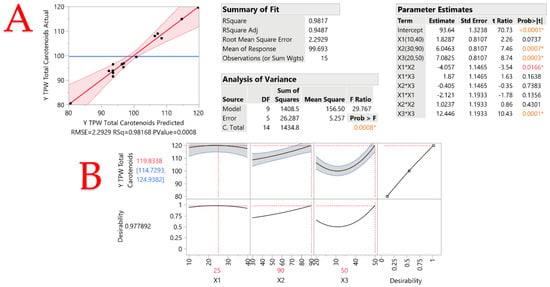
Figure 1
Open AccessReview
A Short Review on Dye-Wastewater Valorization Using Up-Flow Anaerobic Sludge Blanket Reactors
by
Ronei de Almeida and Claudinei de Souza Guimarães
Waste 2023, 1(4), 960-976; https://doi.org/10.3390/waste1040055 - 24 Nov 2023
Abstract
►▼
Show Figures
Dye-containing effluent generated in textile industries is polluting and complex wastewater. It should be managed adequately before its final destination. The up-flow anaerobic blanket (UASB) reactor application is an ecofriendly and cost-competitive treatment. The present study briefly reviews the UASB application for dye-containing
[...] Read more.
Dye-containing effluent generated in textile industries is polluting and complex wastewater. It should be managed adequately before its final destination. The up-flow anaerobic blanket (UASB) reactor application is an ecofriendly and cost-competitive treatment. The present study briefly reviews the UASB application for dye-containing wastewater valorization. Bioenergy and clean-water production potential during dye-containing wastewater treatment are emphasized to promote resource recovery in textile industries. Hydraulic retention time (HRT), organic loading rate (OLR), pH, temperature, and hydraulic mixing influence sludge granulation, microbial activity, and dye removal. HRT and OLR ranges of 6–24 h and 1–12 kg m−3 d−1 of chemical oxygen demand (COD) at a mesophilic temperature (30–40 °C) are recommended for efficient treatment. In these conditions, efficiencies of color and COD of 50–97% and 60–90% are reported in bench-scale UASB studies. Complex dye structures can hinder biomineralization. Pretreatment may be necessary to reduce dye concentration. Carbon-source and redox mediators are added to the UASB reactor to expedite kinetic reactions. A biogas yield of 1.48–2.70 L d−1 in UASB, which treats dye-containing effluents, is documented. Cotreatment of dye wastewater and locally available substrate could increase biogas productivity in UASB reactors. Organic waste generated in the textile industry, such as dye sludge, cotton, and starch, is recommended to make cotreatment cost competitive. Bioenergy production and water reuse allow environmental and economic benefits. Studies on combined systems integrating UASB and membrane processes, such as ultrafiltration and nanofiltration, for the production of reusable water and pretreatment of wastewater and sludge for improvements in biogas production might realize the complete potential for resource recovery of UASB technology. UASB bioenergy usage for integrated treatment trains can reduce operating costs and assist process sustainability in the textile industry.
Full article
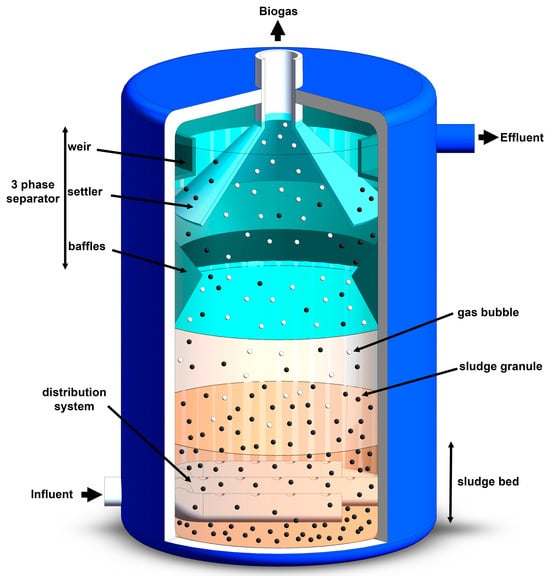
Figure 1
Open AccessReview
A Decade Review of Research Trends Using Waste Materials in the Building and Construction Industry: A Pathway towards a Circular Economy
by
Robert Haigh
Waste 2023, 1(4), 935-959; https://doi.org/10.3390/waste1040054 - 20 Nov 2023
Cited by 3
Abstract
The construction industry is among the most prominent contributors to global resource consumption, waste production, and greenhouse gas emissions. A pivotal step toward mitigating these sectoral impacts lies in the adoption of a circular production and consumption system. The use of alternative waste
[...] Read more.
The construction industry is among the most prominent contributors to global resource consumption, waste production, and greenhouse gas emissions. A pivotal step toward mitigating these sectoral impacts lies in the adoption of a circular production and consumption system. The use of alternative waste materials can mitigate landfill accumulation and the associated detrimental environmental effects. To highlight unconventional materials, this study began with a bibliometric assessment via a bibliography analyzis software called “Bibliometrix” (version 4.1.3). The outputs from the analyzis can assist in identifying research trends, gaps in literature and benchmark research performance. The search engine used for sourcing publications was Scopus, using the main criteria as “Waste materials used in building and construction”. The time-period analysed was from 2013 to 2023. The results included publications obtained in journal articles, book chapters and conference proceedings. The assessment reviewed 6238 documents from 1482 sources. The results revealed an array of waste materials; however, rubber, textiles, and ceramics had a significant reduction in research attention. Rubber waste presents promising opportunities in civil concrete construction methods. The preparatory steps of textile fibres in composite materials are frequently disregarded, resulting in structural issues for the end-product. Obstacles persist in ceramic technology due to the absence of transparency, primarily because industry entities closely safeguard proprietary information. While sustainability research often emphasizes emissions, practical trials commonly revolve around integrating materials into current systems. A more comprehensive approach, contemplating the complete lifecycle of materials, could provide deeper insights into fostering sustainable construction practices. Researchers can use these findings when determining trends, research gaps, and future research directions.
Full article
(This article belongs to the Special Issue Solid Waste Management and Environmental Protection)
►▼
Show Figures
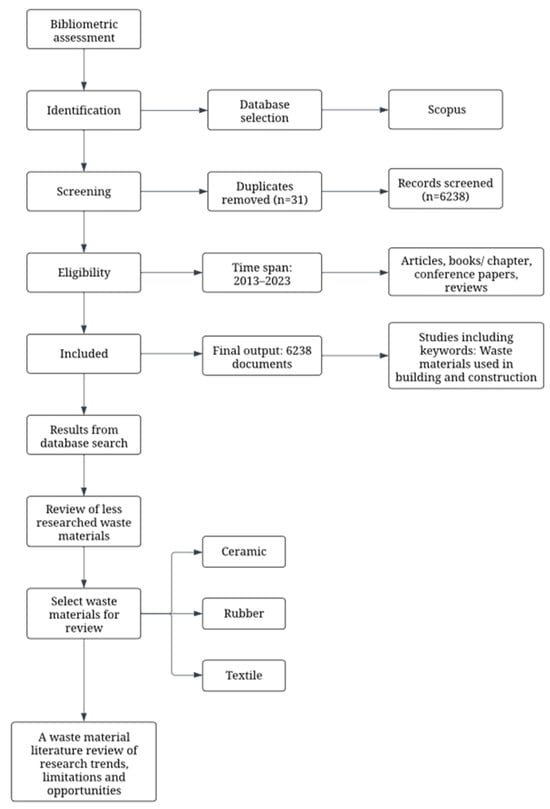
Figure 1
Open AccessArticle
Influences of Management Practices and Methodological Choices on Life Cycle Assessment Results of Composting Mixtures of Biowaste and Green Cuts
by
Ben Joseph and Heinz Stichnothe
Waste 2023, 1(4), 919-934; https://doi.org/10.3390/waste1040053 - 12 Nov 2023
Abstract
►▼
Show Figures
This paper presents an analysis that aimed to quantify the consequences of modelling choices in the life cycle assessment of composting by investigating the influence of composting management practices and the influence of the selected marginal product for substitution. In order to investigate
[...] Read more.
This paper presents an analysis that aimed to quantify the consequences of modelling choices in the life cycle assessment of composting by investigating the influence of composting management practices and the influence of the selected marginal product for substitution. In order to investigate the different influencing factors, a set of 11 scenarios were defined. The scenario results revealed that increasing the turning frequency of the input material leads to a Global warming potential (GWP) reduction of approx. 50%. However, there is a trade-off between GWP reduction and increases in other environmental impacts, including acidification potential (AP), ozone formation potential (OFP), and stratospheric ozone depletion potential (ODP). GWP and AP can also be reduced by optimal exhaust gas filter maintenance, although this causes OFP and ODP to increase. The most relevant factor for GWP is the choice of substituted products. When peat for horticulture can be replaced, GWP can be substantially lowered while hardly affecting other environmental impacts.
Full article

Figure 1
Open AccessArticle
Amount of Fill Product Residues in Plastic Packagings for Recycling
by
Konstantin Schinkel, Bastian Küppers, Sven Reichenbach, Teresa Rohrmeier, Kajetan Müller, Tanja Fell and Sven Sängerlaub
Waste 2023, 1(4), 901-918; https://doi.org/10.3390/waste1040052 - 09 Oct 2023
Abstract
►▼
Show Figures
Fill product residues in packagings are equivalent to product losses. They are washed out after sorting and before commencing recycling processes. Not much data have been published about how much fill product is still present in packagings dedicated for recycling. Results are often
[...] Read more.
Fill product residues in packagings are equivalent to product losses. They are washed out after sorting and before commencing recycling processes. Not much data have been published about how much fill product is still present in packagings dedicated for recycling. Results are often from laboratory trials. Therefore, several hundred packagings from a sorting plant of a dual system in Germany were analysed to determine the amount of fill product residues. Approximately 10 wt. % of highly viscous fill products in tubes were lost as residue. In the case of packagings that were easy to empty, such as cups, and in the case of low-viscosity fill products, such as water, less than 1 wt. % of the fill products remained in the packagings. The mean amount of residue in relation to clean packaging was 0.9 g residue in 1 g of packaging material (without residue) in tubes and 0.07 g in PET bottles. These values were significantly lower for low-viscosity fill products compared to high-viscosity fill products, as expected.
Full article

Figure 1
Open AccessArticle
Valorizing the Input and Output Waste Streams from Three PtX Case Studies in Denmark—Adopting a Symbiotic Approach
by
Rikke Lybæk and Tyge Kjær
Waste 2023, 1(4), 884-900; https://doi.org/10.3390/waste1040051 - 06 Oct 2023
Abstract
This study aimed to investigate the waste streams from the production of hydrogen energy carriers from PtX technology and identify how they can be valorized by applying a symbiotic approach to enable greater utilization of the inputs and outputs from such plants. Various
[...] Read more.
This study aimed to investigate the waste streams from the production of hydrogen energy carriers from PtX technology and identify how they can be valorized by applying a symbiotic approach to enable greater utilization of the inputs and outputs from such plants. Various electrolysis development projects are under development or in the pipeline in Europe and Denmark, but in many cases, it is not clear how waste streams are emphasized and valued in these projects. Thus, three exploratory case studies (a city, a rural, and an energy hub case) were investigated herein exemplifying state-of-the-art electrolysis projects currently being deployed, with a focus on identifying how and to what extent waste streams are being valorized in these projects and energy system integration is being pursued. Inspired by the industrial symbiosis literature, we analyzed how internal, regional, and long-distance symbiotic collaboration is realized within these cases and found them to be very different in terms of the energy carrier produced, the current development stage, and the access to appropriate energy infrastructure. This paper concludes that the co-location of PtX technology near biogas plants would provide a great opportunity for the integration of the produced energy carriers and waste streams into the existing energy system and, hence, could assist in stabilizing fluctuating renewable energy sources to enable their more efficient use in the energy system.
Full article
(This article belongs to the Topic Valorizing Waste through Thermal and Biological Processes for Sustainable Energy Production)
►▼
Show Figures

Figure 1
Open AccessReview
Mechanical Recycling of Thermoplastics: A Review of Key Issues
by
Alae Lamtai, Said Elkoun, Mathieu Robert, Frej Mighri and Carl Diez
Waste 2023, 1(4), 860-883; https://doi.org/10.3390/waste1040050 - 04 Oct 2023
Cited by 1
Abstract
During the last decade, the consumption of plastics has increased highly in parallel with plastic waste. The transition towards a circular economy is the only way to prevent the environment from landfilling and incineration. This review details the recycling techniques with a focus
[...] Read more.
During the last decade, the consumption of plastics has increased highly in parallel with plastic waste. The transition towards a circular economy is the only way to prevent the environment from landfilling and incineration. This review details the recycling techniques with a focus on mechanical recycling of polymers, which is the most known and developed technique in industries. The different steps of mechanical recycling have been highlighted, starting from sorting technologies to the different decontamination processes. This paper covers degradation mechanisms and ways to improve commodity polymers (Polyolefins), engineering polymers (PET, PA6), and bio-sourced polymers (PLA and PHB).
Full article
(This article belongs to the Special Issue Solid Waste Management and Environmental Protection)
►▼
Show Figures
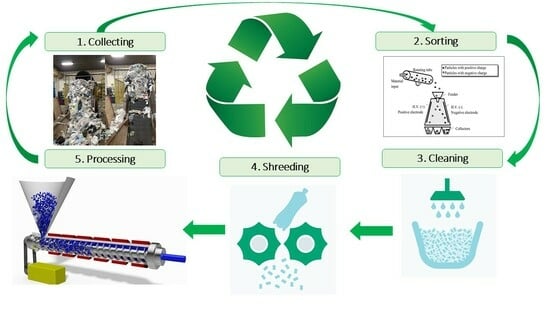
Graphical abstract
Open AccessReview
Overview of the Biotransformation of Limonene and α-Pinene from Wood and Citrus Residues by Microorganisms
by
Adama Ndao and Kokou Adjallé
Waste 2023, 1(4), 841-859; https://doi.org/10.3390/waste1040049 - 04 Oct 2023
Abstract
This review provides an overview of the biotransformation of limonene and α-pinene, which are commonly found in wood residues and citrus fruit by-products, to produce high-value-added products. Essential oils derived from various plant parts contain monoterpene hydrocarbons, such as limonene and pinenes which
[...] Read more.
This review provides an overview of the biotransformation of limonene and α-pinene, which are commonly found in wood residues and citrus fruit by-products, to produce high-value-added products. Essential oils derived from various plant parts contain monoterpene hydrocarbons, such as limonene and pinenes which are often considered waste due to their low sensory activity, poor water solubility, and tendency to autoxidize and polymerise. However, these terpene hydrocarbons serve as ideal starting materials for microbial transformations. Moreover, agro-industrial byproducts can be employed as nutrient and substrate sources, reducing fermentation costs, and enhancing industrial viability. Terpenes, being secondary metabolites of plants, are abundant in byproducts generated during fruit and plant processing. Microbial cells offer advantages over enzymes due to their higher stability, rapid growth rates, and genetic engineering potential. Fermentation parameters can be easily manipulated to enhance strain performance in large-scale processes. The economic advantages of biotransformation are highlighted by comparing the prices of substrates and products. For instance, R-limonene, priced at US$ 34/L, can be transformed into carveol, valued at around US$ 530/L. This review emphasises the potential of biotransformation to produce high-value products from limonene and α-pinene molecules, particularly present in wood residues and citrus fruit by-products. The utilisation of microbial transformations, along with agro-industrial byproducts, presents a promising approach to extract value from waste materials and enhance the sustainability of the antimicrobial, the fragrance and flavour industry.
Full article
(This article belongs to the Special Issue Agri-Food Wastes and Biomass Valorization)
►▼
Show Figures
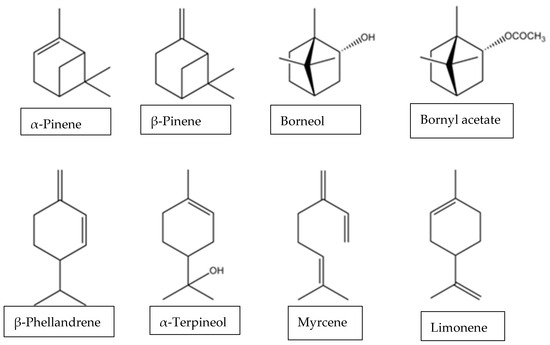
Figure 1
Open AccessReview
A Review of Beneficial Use and Management of Dredged Material
by
Pranshoo Solanki, Bhupesh Jain, Xi Hu and Gaurav Sancheti
Waste 2023, 1(3), 815-840; https://doi.org/10.3390/waste1030048 - 10 Sep 2023
Cited by 4
Abstract
This study systematically examined dredged materials from various aspects, including their sources, the volume generated annually, beneficial uses, and the management processes currently practiced. In addition, this paper presents the relevant policies governing the dredging, reuse, and disposal of dredged materials in the
[...] Read more.
This study systematically examined dredged materials from various aspects, including their sources, the volume generated annually, beneficial uses, and the management processes currently practiced. In addition, this paper presents the relevant policies governing the dredging, reuse, and disposal of dredged materials in the United States. A summary of various sources, types/classifications, and the physical and chemical properties of dredged materials used by various researchers are presented. This paper also summarizes the innovative techniques for the beneficial reuse of dredged materials in a wide range of applications in concrete materials, construction products, roadway construction, habitat building, landfill liner/cap, agriculture soil reconstruction, and beach nourishment. Further, limitations and corresponding solutions related to the beneficial use and management of dredged materials were provided in the end.
Full article
(This article belongs to the Special Issue Solid Waste Management and Environmental Protection)
►▼
Show Figures
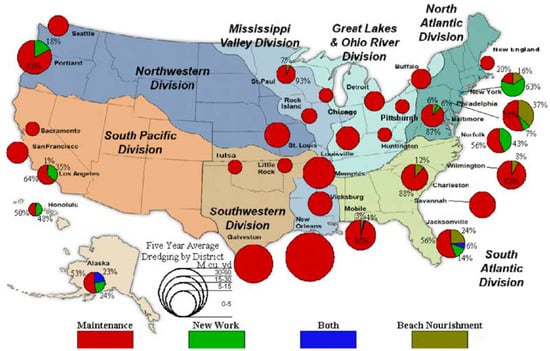
Figure 1
Highly Accessed Articles
Latest Books
E-Mail Alert
News
Topics
Topic in
Energies, Catalysts, Fermentation, Processes, Waste
Valorizing Waste through Thermal and Biological Processes for Sustainable Energy Production
Topic Editors: Margarida Gonçalves, Cândida VilarinhoDeadline: 31 August 2024
Topic in
Energies, Materials, Molecules, Waste, Water
Advances in Organic Solid Waste and Wastewater Management
Topic Editors: Alejandro Alvarado-Lassman, Carlos Velasco-Santos, Juan Manuel Méndez-ContrerasDeadline: 30 November 2024
Topic in
Catalysts, Energies, Processes, Sustainability, Waste, Water, Molecules, Nanomaterials
New Research on Waste Treatment, Disposal and Valorization
Topic Editors: Antonella Angelini, Carlo PastoreDeadline: 31 March 2025

Conferences
Special Issues
Special Issue in
Waste
New Trends in Liquid and Solid Effluent Treatment
Guest Editors: Gassan Hodaifa, Mha Albqmi, Zacharias FrontistisDeadline: 30 April 2024
Special Issue in
Waste
Conversion of Fruit and Vegetable Waste into Sustainable and Value-Added Materials
Guest Editors: Raluca Nicoleta Darie-Nita, Maria RâpăDeadline: 31 July 2024
Special Issue in
Waste
Agri-Food Wastes and Biomass Valorization—2nd Edition
Guest Editors: Dimitris Makris, Vassilis AthanasiadisDeadline: 31 October 2024

